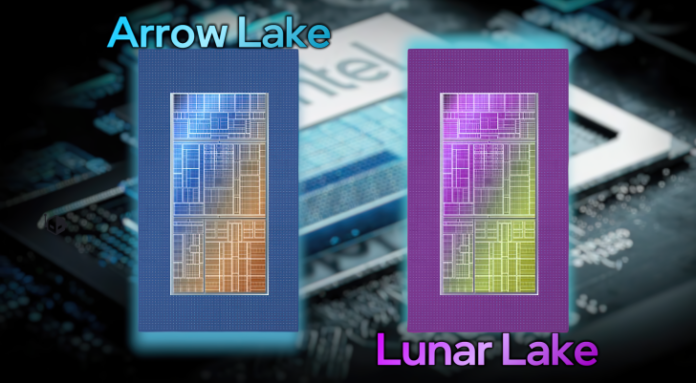
As the Intel Meteor Lake launch nears, rumors on the next-gen Arrow Lake & Lunar Lake CPUs have already started floating on the internet.
Intel Arrow Lake & Lunar Lake CPUs To Feature Next-Gen Lion Cove & Skymont Core Architectures
It's no secret that the Arrow Lake and Lunar Lake CPUs will be replacing Meteor Lake CPUs in 2024 and 2025, respectively. These next-gen CPU families have already been confirmed by Intel & based on what we know, they are going to be another incremental step into the disaggregated future that Intel is keen on developing. As OneRaichu states:
- Arrow Lake-H CPUs - Lion Cove P-Core + Skymont E-Core + Crestmont LP E-Cores (SOC)
- Lunar Lake-M CPUs - Lion Cove P-Core + Skymont E-Core + Skymont LP E-Cores (SOC)
We know that Intel Arrow Lake CPUs are expected to feature the next-generation Lion Cove P-Core & Skymont E-Core architecture. Now as per a rumor by OneRaichu, it looks like the 2nd Gen Arrow Lake-H "Core Ultra" CPUs might be equipped with a different sub-core for the SOC tile. While Arrow Lake-H CPUs would feature Skymont E-Cores on the Compute Tile, the SOC Tile may adopt Meteor Lake's Crestmont E-Cores. These E-Cores will be designed for low-power workloads and function in a similar way as the Meteor Lake LP E-Cores.

The Arrow Lake-H CPUs will have the compute tile fabricated on the Intel 20A process node while the other tiles will be using 3rd party and external nodes such as the 3nm process node for iGPU.
As for Intel Lunar Lake-M, the CPU lineup is expected to utilize either the 20A or 18A process node for its Compute Tile. There are good indications that it might be based on 20A due to its readiness compared to 18A. Intel also recently showed a working Lunar Lake chip at its Innovation event and that is also evidence that 20A is the potential process for Lunar Lake chips with Panther Lake going in the sub-20A category. The compute tile for Lunar Lake CPUs is said to be composed of the same Lion Cove P-Cores and Skymont E-Cores but the SOC tile will also feature Skymont LP E-Cores.
This aligns with recent reports of Lunar Lake featuring a bigger VPU/NPU upgrade over the Meteor Lake and Arrow Lake CPUs. Intel's Lunar Lake-M CPUs will be targeted solely at the low-power and mobility platforms with a focus set on delivering the best performance/watt capabilities. The lineup will be introduced around CES 2025. Just like Meteor Lake CPUs, the Lunar Lake lineup won't see a desktop "socketed" release.
Intel Mobility CPU Lineup:
| CPU Family | Lunar Lake | Arrow Lake | Meteor Lake | Raptor Lake | Alder Lake |
|---|---|---|---|---|---|
| Process Node (CPU Tile) | Intel 20A? | Intel 20A '5nm EUV" | Intel 4 '7nm EUV' | Intel 7 '10nm ESF' | Intel 7 '10nm ESF' |
| Process Node (GPU Tile) | TSMC 3nm? | TSMC 3nm | TSMC 5nm | Intel 7 '10nm ESF' | Intel 7 '10nm ESF' |
| CPU Architecture | Hybrid | Hybrid (Four-Core) | Hybrid (Triple-Core) | Hybrid (Dual-Core) | Hybrid (Dual-Core) |
| P-Core Architecture | Lion Cove? | Lion Cove | Redwood Cove | Raptor Cove | Golden Cove |
| E-Core Architecture | Skymont? | Skymont | Crestmont | Gracemont | Gracemont |
| LP E-Core Architecture (SOC) | Skymont? | Crestmont? | Crestmont? | N/A | N/A |
| Top Configuration | TBD | TBD | 6+8 (H-Series) | 6+8 (H-Series) 8+16 (HX-Series) | 6+8 (H-Series) 8+8 (HX-Series) |
| Max Cores / Threads | TBD | TBD | 14/20 | 14/20 | 14/20 |
| Planned Lineup | U Series? | H/P/U Series | H/P/U Series | H/P/U Series | H/P/U Series |
| GPU Architecture | Xe2-LPG (Battlemage) | Xe-LPG (Alchemist) | Xe-LPG (Alchemist) | Iris Xe (Gen 12) | Iris Xe (Gen 12) |
| GPU Execution Units | 64 EUs | 192 EUs | 128 EUs (1024 Cores) | 96 EUs (768 Cores) | 96 EUs (768 Cores) |
| Memory Support | TBD | TBD | DDR5-5600 LPDDR5-7400 LPDDR5X - 7400+ | DDR5-5200 LPDDR5-5200 LPDDR5-6400 | DDR5-4800 LPDDR5-5200 LPDDR5X-4267 |
| Memory Capacity (Max) | TBD | TBD | 96 GB | 64 GB | 64 GB |
| Thunderbolt 4 Ports | TBD | TBD | 4 | 4 | 4 |
| WiFi Capability | TBD | TBD | WiFi 6E | WiFi 6E | WiFi 6E |
| TDP | TBD | TBD | 7W-45W | 15-55W | 15-55W |
| Launch | ~2025 | 2H 2024 | 2H 2023 | 1H 2023 | 1H 2022 |
WccftechContinue reading/original-link]





